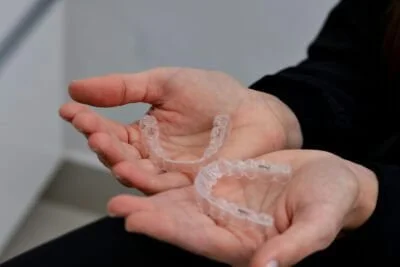Does Invisalign Hurt?
If you’re considering Invisalign to straighten your teeth, you may be wondering: Does Invisalign hurt? The short answer is that Invisalign can cause mild discomfort, especially when starting a new aligner tray, but it’s generally far less painful than traditional braces. Let’s explore what you can expect when it comes to comfort and how to manage any potential discomfort.
What is Invisalign?
Invisalign is a popular orthodontic treatment that uses clear aligners to gradually shift your teeth into the desired position. Unlike metal braces, Invisalign aligners are nearly invisible, removable, and custom-made for your teeth. This innovative approach to teeth straightening is favoured for its discreet appearance and convenience. For further information check out our Invisalign page
Does Invisalign Hurt? What to Expect
While Invisalign is designed with comfort in mind, some users experience mild pain or discomfort, especially during the following phases:
First Few Days: When you start wearing Invisalign, your teeth may feel sore as they adjust to the pressure from the aligners. This sensation is similar to the discomfort felt after tightening traditional braces.
Switching Aligners: Every 1-2 weeks, you will transition to a new set of aligners. The initial days with a new tray may result in slight pressure or tenderness as your teeth continue to shift.
Chewing and Biting: Some users report tenderness when chewing or biting, particularly in the early stages of treatment.
Why Does Invisalign Cause Discomfort?
The mild pain or pressure you might feel is a sign that the treatment is working. Invisalign applies controlled force to move your teeth into their proper alignment. This force stimulates the bone remodelling process around your teeth, which can cause temporary soreness.
Tips to Manage Invisalign Discomfort
For further information, the British Orthodontic Society provides excellent advice on maintaining oral health during orthodontic treatment. Additionally, WebMD’s Guide to Invisalign offers a comprehensive overview of the treatment process and tips to ensure comfort.
Although the discomfort is usually minimal and short-lived, there are several ways to manage and reduce it:
Wear Aligners Consistently: Stick to the recommended 20-22 hours of daily wear to help your teeth adjust faster and reduce discomfort.
Use Over-the-Counter Pain Relievers: Non-prescription painkillers like ibuprofen or paracetamol can help ease soreness during the adjustment period.
Switch Aligners Before Bed: Start using a new aligner tray at night so you can sleep through the initial adjustment period.
Rinse with Warm Salt Water: A gentle rinse can soothe irritated gums and teeth.
Chew on Aligner “Chewies”: These small, soft tools help seat the aligners properly and alleviate pressure points.
How Long Does Invisalign Discomfort Last?
The discomfort associated with Invisalign is usually temporary. Most users report that soreness diminishes within a few days of starting a new aligner tray. By the second or third day, the aligners feel much more comfortable as your teeth adjust to the pressure.
When to Consult Your Orthodontist
If the pain persists for more than a week or becomes severe, consult your orthodontist. They can check for issues like improperly fitted aligners or other complications. Regular check-ups ensure your Invisalign journey is progressing smoothly.

